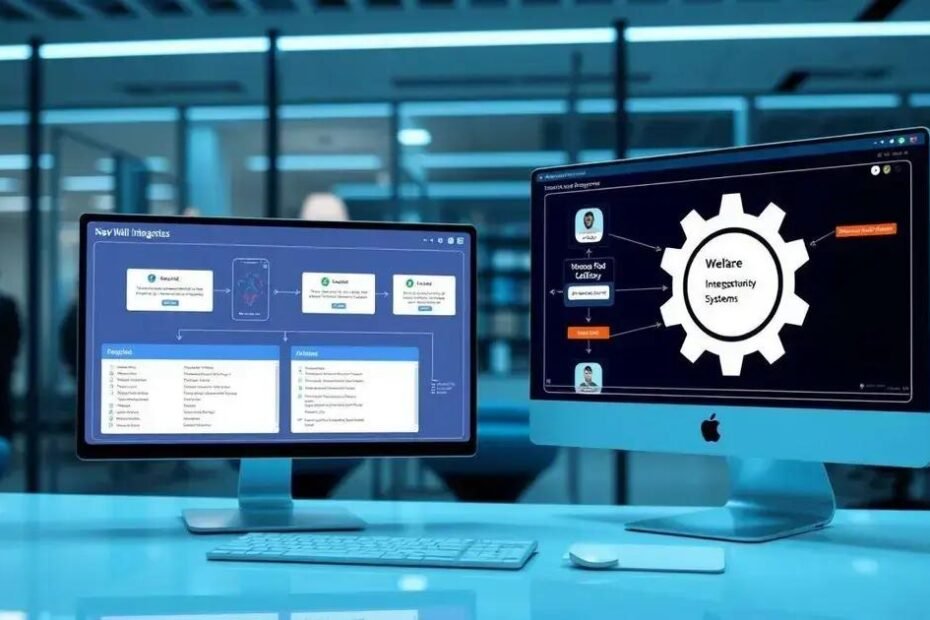The integration of welfare agency systems enhances service delivery by utilizing technology for better communication, data sharing, and resource allocation, addressing the unique needs of diverse communities.
Integration of welfare agency systems is becoming essential as agencies strive for greater efficiency and service delivery. Have you ever wondered how interconnected systems can simplify processes and improve outcomes for those in need? Let’s dive into this crucial topic.
Understanding welfare agency systems
Understanding welfare agency systems is key to improving service delivery and ensuring that communities receive the support they need. These systems are designed to provide essential services, such as food assistance, housing support, and healthcare, to individuals and families in need.
By integrating information and resources, welfare agencies can enhance their effectiveness. This integration not only streamlines processes but also helps in tracking the needs of the community more accurately. As we explore this topic further, we will see how understanding these systems can make a real difference.
Components of welfare agency systems
A typical welfare agency system includes several important components:
- Case management: A system to manage individual cases and track progress.
- Data management: Tools to collect and analyze data about community needs and service outcomes.
- Resource allocation: Efficient distribution of available resources to meet demands.
- Feedback mechanisms: Channels for community feedback to improve services.
These components work together to ensure that welfare agencies not only respond to crises but also anticipate and plan for future needs. By utilizing technology and maintaining effective communication with service users, agencies can adapt and evolve.
The role of technology
Technology plays a critical role in the functioning of welfare agency systems. With advancements in software and communication tools, agencies can enhance their interactions with clients. For instance, online applications for aid can make the process quicker and easier for both clients and staff. Furthermore, data analytics can provide valuable insights into community trends and service effectiveness.
Moreover, technology allows for better coordination between different agencies. This coordination means that when a client visits one agency, their information can be shared (with permission) to help in locating available resources and services more effectively. These developments lead to better outcomes for individuals seeking help.
In conclusion, understanding welfare agency systems involves recognizing their components and the importance of technology in enhancing their functionality. By streamlining processes and improving communication, these systems can provide more effective service delivery and support for those who need it most.
Benefits of integration in welfare services
The benefits of integration in welfare services are substantial and impact both service providers and recipients. When welfare services integrate effectively, they create a seamless experience for clients seeking assistance.
One major advantage is the improved efficiency of service delivery. By streamlining processes and eliminating redundant steps, agencies can respond more quickly to the needs of individuals. This efficiency not only saves time but also resources, allowing agencies to do more with their available funds.
Enhanced Communication
Integration fosters better communication between various welfare agencies. When different services share information, it allows for a more coordinated approach to meeting the needs of families. For example, a family receiving food assistance may also benefit from housing support, and integrated systems ensure that these services work together.
- Holistic support: Clients receive comprehensive services tailored to their unique circumstances.
- Timely assistance: Reduced waiting times for aid and better follow-ups.
- Personalized service: Understanding specific needs leads to targeted help.
- Resource sharing: Agencies can pool resources for maximum impact.
This kind of collaboration leads to stronger relationships between clients and service providers. When clients feel supported and understood, they are more likely to engage with the services offered.
Increased Accessibility
Integration also enhances the accessibility of welfare services. By creating a unified platform, individuals can more easily navigate between different types of assistance, making it less daunting to get help. When all necessary resources are in one place, clients can address multiple needs without having to visit several locations.
Additionally, the use of technology can facilitate access. Online services and mobile apps allow clients to access assistance from the comfort of their homes. This is particularly important for individuals who may have mobility issues or who lack reliable transportation.
Overall, the benefits of integration in welfare services extend beyond efficiency; they promote a more client-centered approach. By making services more accessible and fostering better communication, welfare agencies can help individuals and families achieve better outcomes.
Strategies for effective system integration

Implementing strategies for effective system integration in welfare agencies can transform how services are delivered. These strategies focus on enhancing collaboration and improving the coordination of efforts among various agencies. One key strategy is to establish clear communication channels. When agencies share important information and updates, it fosters a culture of cooperation.
Training staff on these communication protocols is essential. Well-informed employees can better assist clients by knowing which services are available and how to access them. Furthermore, regular meetings among service providers can strengthen relationships and enhance teamwork.
Utilizing Technology
Another strategy involves leveraging technology. Utilizing shared software platforms can create a unified database where agencies can access relevant information. This database can include case histories, resources, and service offerings, making it easier for workers to collaborate.
- Data sharing: Allowing real-time access to information helps workers understand clients’ needs better.
- Community platforms: Creating a single-online portal for clients to connect with various services can simplify access.
- Feedback tools: Implementing feedback systems allows clients to share their experiences, helping agencies improve services.
- Mobile applications: Offering services through apps can increase accessibility and engagement.
Adopting these technologies leads to a more efficient use of resources and ultimately benefits clients needing assistance.
Continuous Improvement
A final strategy is embracing a culture of continuous improvement. Agencies should regularly assess their integration efforts and seek feedback from both clients and staff. This assessment can highlight areas where integration could be enhanced further, ensuring that agencies adapt to the changing needs of their communities.
Creating a feedback loop not only helps identify problems but also celebrates successes, motivating staff to keep striving for excellence. When agencies prioritize constant enhancement, they can maintain high-quality service delivery and better outcomes for those they serve.
Common challenges in welfare system integration
Understanding the common challenges in welfare system integration is crucial for agencies aiming to improve their services. Integration can offer many benefits, but it also comes with obstacles that need to be addressed carefully.
One significant challenge is the resistance to change from personnel. Staff members may be accustomed to their current processes and reluctant to adopt new systems. This can stall integration efforts, making it essential to provide training and demonstrate the advantages of the new approach.
Data Privacy Concerns
Another major hurdle is ensuring data privacy and security. As agencies integrate their systems, they must navigate the complexities of sharing sensitive client information. Maintaining compliance with regulations, like HIPAA, is vital to protect client confidentiality.
- Protecting client information: Agencies need effective protocols to safeguard data.
- Ensuring compliance: Legal requirements must be met to avoid penalties.
- Training staff: Employees should be educated about privacy policies and data security.
- Transparent communication: Clients should be informed about how their data is used.
Addressing these privacy issues requires effective communication and updated policies that ensure clients feel secure in sharing their information.
Resource Limitations
Resource limitations pose another significant challenge. Many welfare agencies often operate on tight budgets, which can affect their ability to invest in new technology or staffing for integration efforts. Without sufficient resources, it becomes challenging to achieve effective integration.
It’s essential to prioritize funding and look for innovative solutions that can maximize existing resources. Collaborating with other organizations can provide mutual benefits and help alleviate some of the financial pressures.
Lastly, achieving a unified approach among diverse agencies can be difficult. Each agency has its own culture, operational procedures, and goals, making it challenging to establish a common framework. Effective leadership and a clear vision are necessary for guiding these agencies toward successful collaboration.
Future trends in welfare agencies’ integration
The future of welfare agencies’ integration lies in innovation and adaptability. As society changes, these agencies must evolve to meet the demands of their communities effectively. One emerging trend is the increased use of technology to enhance service delivery. With the rise of digital platforms, agencies are beginning to adopt more efficient systems for managing client data and service requests.
These technological advancements not only improve accessibility but also streamline processes. For instance, the use of mobile apps allows clients to apply for services from anywhere, making it easier for those who might have mobility or transportation issues.
Data-Driven Decision Making
Another significant trend is the emphasis on data-driven decision-making. By analyzing data collected from clients and services, welfare agencies can better understand the needs of the populations they serve. This information can guide resource allocation and help in developing targeted programs.
- Predictive analytics: Agencies can anticipate client needs based on historical data.
- Impact assessment: Evaluating the effectiveness of programs ensures funds are used wisely.
- Personalized services: Tailoring programs to individual needs improves outcomes.
- Collaboration: Sharing data across agencies fosters a comprehensive approach to welfare services.
As agencies integrate their systems, they embrace a culture of continuous improvement. This approach focuses on constantly assessing and refining services based on feedback and performance metrics.
Emphasis on Equity and Inclusion
The integration of welfare agencies will increasingly prioritize equity and inclusion. As communities become diverse, understanding different cultural backgrounds is essential. Agencies are working to ensure that their services are accessible to all individuals, regardless of their circumstances.
Training staff on cultural competence is vital for creating an inclusive environment. This training helps workers understand and respect the unique needs and challenges faced by various communities. By fostering an inclusive culture, welfare agencies can build trust and rapport with clients.
In conclusion, the future of welfare agencies’ integration promises to be dynamic, characterized by technological advancements and a commitment to equity. These changes will help agencies respond to the evolving needs of their communities effectively and efficiently.
The integration of welfare agency systems is not simply a trend; it’s a necessary evolution. By embracing technology, prioritizing equity, and fostering collaboration, agencies can provide better services to the communities they serve. The future holds great promise as these agencies transform their approaches to meet the diverse needs of individuals and families. Now, as they look ahead, they can create a more inclusive and effective system that truly supports those in need.
FAQ – Common Questions About Integration of Welfare Agency Systems
What are the main benefits of integrating welfare agency systems?
Integration improves efficiency, enhances communication, and ensures better service delivery to clients by pooling resources and information.
How does technology aid in welfare system integration?
Technology enables the use of shared databases, online applications, and mobile apps, making services more accessible and easier to manage.
What challenges do welfare agencies face in integration?
Common challenges include data privacy concerns, resistance to change from staff, and limited resources for implementing new systems.
Why is data-driven decision-making important in welfare services?
Data-driven decision-making helps agencies understand client needs better and allocate resources more effectively, leading to improved outcomes.

